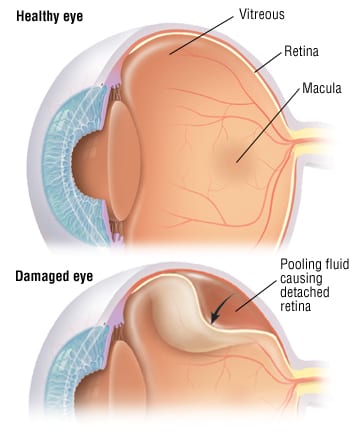DIABETIC RETINOPATHY
Diabetic retinopathy is a complication of diabetes and a leading cause of blindness. It occurs when diabetes damages the tiny blood vessels inside the retina, the light-sensitive tissue at the back of the eye. A health retina is necessary for good vision. If you have diabetic retinopathy, at first you may notice no changes in your vision. But over time, diabetic retinopathy can get worse and cause vision loss. Diabetic retinopathy usually affects both eyes.
SYMPTOMS
Blurred vision (this is often linked to blood sugar levels)
Floaters and flashes
Sudden loss of vision
REMEMBER
If you have diabetes, get a comprehensive dilated eye exam at least once a year.
Proliferative retinopathy can develop without symptoms. At this advanced stage, you are at high risk for vision loss.
Macular edema can develop without symptoms at any of the four stages of diabetic retinopathy.
You can develop both proliferative retinopathy and macular edema and still see fine. However, you are at high risk for vision loss.
Your eye care professional can tell if you have macular edema or diabetic retinopathy. Early detection and timely treatment can prevent vision loss.
STAGES OF DIABETIC RETINOPATHY
Neovascularization, Hemorrhages, "Cotton-wool"spotsBackground Diabetic Retinopathy Proliferative Diabetic Retinopathy
Diabetic retinopathy has four stages:
Mild Nonproliferative Retinopathy. At this earliest stage, micro aneurysms occur. They are small areas of balloon-like swelling in the retina?s tiny blood vessels.
Moderate Nonproliferative Retinopathy. As the disease progresses, some blood vessels that nourish the retina are blocked.
Severe Nonproliferative Retinopathy. Many more blood vessels are blocked, depriving several areas of the retina with their blood supply. These areas of the retina send signals to the body to grow new blood vessels for nourishment.
Proliferative Retinopathy. At this advanced stage, the signals sent by the retina for nourishment trigger the growth of new blood vessels. This condition is called proliferative retinopathy. These new blood vessels are abnormal and fragile. They grow along the retina and along the surface of the clear, vitreous gel that fills the inside of the eye.




